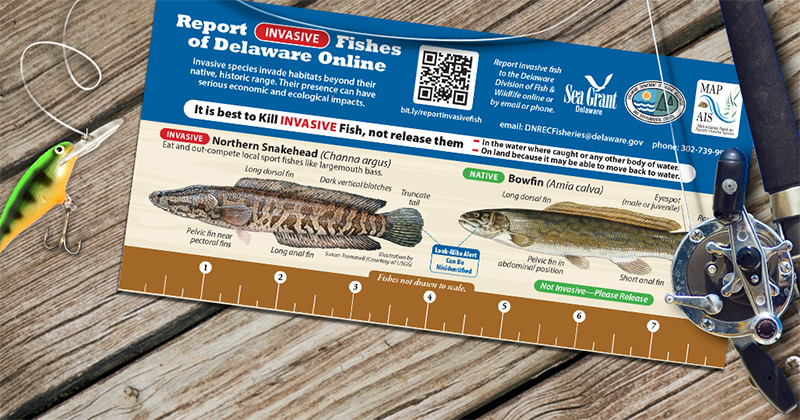


Aquatic invasive species
Photo illustration by Tammy Beeson July 14, 2021
Delaware Sea Grant shares information on invasive fish, crabs
Editor’s Note: Since the University of Delaware was designated the nation's ninth Sea Grant College in 1976, the goal of Delaware Sea Grant (DESG) has been to promote the wise use, conservation, and management of marine and coastal resources through high-quality research, education, and outreach activities that benefit the public and the environment. This story comes from Delaware Sea Grant’s annual publication, Reporter, now available in print and online. As in this story, the Reporter highlights how DESG rose to the challenge and supported its communities in 2020.
Aquatic invasive species disrupt normal ecosystem functions in Delaware and can cause extensive damage to the state’s waterways. Flathead catfish, for example, have been found to feed on native fish including American shad, blueback herring and other species of significant economic concern such as blue crabs.
Invasive species compete with native organisms for limited resources and can permanently alter habitats by causing extinctions of native plants and animals, which results in significant economic impacts in addition to disrupting aquatic ecosystems.
To help inform recreational fishers, the general public and students of the dangers of invasive species, Delaware Sea Grant (DESG) developed a three-pronged informational approach on how to identify and what to do when encountering aquatic invasive species.
The project was funded by the Mid-Atlantic panel on Aquatic Invasive Species and involved several of DESG’s Marine Advisory Service specialists: Kate Fleming, who is the principal investigator for the project, Ed Hale, David Christopher and Chris Petrone.
For recreational fishers, Hale recorded a presentation on aquatic invasive species that was distributed to local fishing clubs and Fleming sent them waterproof rack cards to hand out with information on invasive fish and how to report those invasive fish to local management agencies.
Developed by Fleming and DESG’s Environmental Public Education Office, the rack card highlights three invasive fish — northern snakehead, flathead catfish and blue catfish — and also their similar looking counterparts bowfin and channel catfish. The card includes instructions on what to do if an invasive fish is caught. It is recommended to kill invasive species and not return them to the water — especially not to another area where they weren’t caught. There is a QR code, email and phone number on the card where users can report invasive species to the Delaware Department of Natural Resources and Environmental Control (DNREC).
These cards were also distributed to state parks throughout Delaware as well as town parks in Milford, Seaford and Bethany Beach.
“People in the recreational fishing community and the general public need to be taught how to properly identify these species,” said Hale, “so that they don’t misreport commonly mistaken species, and they need to learn where to report sightings and how to properly and humanely euthanize these fish, so that they can help with invasive species management in local waterways.”
Anglers have not been the only audience for DESG education, however. Christopher, DESG’s education specialist, developed a high school lesson on Invasive Crabs in Delaware.
The lesson, which was partially designed by Catherine Czajka, a summer intern for DESG, focuses on the European Green Crab, the Asian Shore Crab and the Chinese Mitten Crab and was presented at a #75MinuteScience workshop on Feb. 23, 2021.
Darrick Sparks from the Smithsonian Environmental Research Center spoke and then Christopher presented the lesson.
“Teachers seemed to really like the lesson and using a Story Map allows them to share it easily with students who are learning from home during the pandemic,” said Christopher.
In addition, DESG used the 15-Second Science Video Series to address the problems posed by invasive aquatic species, and the program leveraged its relationship with the Osher Lifelong Learning Institute, with Hale, Christopher and Fleming presenting on invasive aquatic species to about 80 participants. The videos, story maps, fish ID card and more resources can be seen at deseagrant.org/invasive-species.
Fleming said that it was great to be part of a collaborative DESG effort to inform Delawareans about the impacts of aquatic invasive species.
“This project came out of a brainstorming session between all of us,” said Fleming. “We’ve been working together to build awareness and outreach related to aquatic invasive species in Delaware and it’s been a great collaborative, team effort.”
Contact Us
Have a UDaily story idea?
Contact us at ocm@udel.edu
Members of the press
Contact us at 302-831-NEWS or visit the Media Relations website

